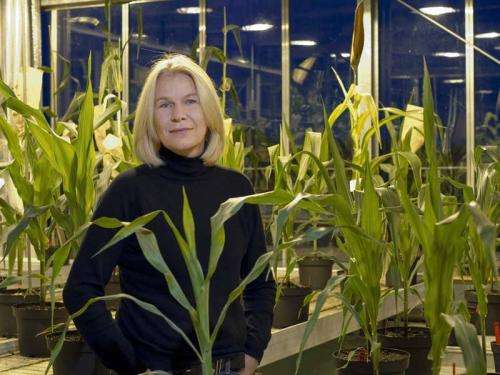Synbreed project bridges the gap between animal and plant breeding

From healthier cattle to corn that is better adapted to climate change, the Synbreed project has made major breakthroughs in animal and plant breeding. The methods used are based on DNA analysis, which allows scientists to identify characteristics in animals and plants that are particularly advantageous for breeding. In contrast to other common processes, genome-based breeding is a much faster - and predictable - route to success.
Agriculture and breeding are inextricably linked. Down through the ages, humans have cross-bred very high-yield or highly resistant fruits and grains or bred animals selectively to ensure that they passed on desirable traits.
Conventional breeding is a time-consuming affair, however: while the desirable characteristic- "more milk" for example - may be obvious, not so much is known about the underlying genetics. So it is difficult to assess in advance whether the parent animals or plants will actually pass on the required trait. The success of the process is only apparent when subsequent generations are born or cultivated. It can often take decades for a particular characteristic to become firmly established in a line of animals or plants.
In order to improve breeding processes and perform basic research on genome-based approaches, the Synbreed cluster headed by Technische Universität München (TUM) was set up in 2009.
Big data provides answers for successful breeding
Tiny differences in DNA are often what determine the strength of an eggshell or a plant's compatibility with saline soil. As part of the project, the scientists studied the genes of different corn varieties and of cattle and chickens, analyzing thousands of samples. Their objective was to find the gene combinations responsible for desirable characteristics.
"The big data approach delivered genome information on different phenotypes over a number of years," relates project leader Prof. Chris-Carolin Schön from TUM's Chair of Plant Breeding. "For example, we were able to evaluate with high accuracy the breeding value of new strains of corn and determine whether they would consistently perform well in different environmental conditions, from chilly weather in spring to extreme heat in summer.
Focus on healthier and more robust animals
In Germany, the practice of collecting the genetic fingerprints of breeding bulls was introduced in 2009. During the Synbreed project, the team under Prof. Ruedi Fries (TUM Chair of Animal Breeding) discovered which gene sequences were responsible for the dark pigmentation around the eyes of Fleckvieh cattle. The pigment acts like sunglasses, protecting the animals' eyes against UV rays and possible tumors. "This characteristic would be particularly useful for Fleckvieh cattle in countries further south - and now we can selectively breed it into animals," explains Fries.
The researchers also detected a genetic defect that makes breeding bulls more or less infertile. "Thanks to the techniques developed during the Synbreed project, successful breeding can be achieved twice as fast as with conventional methods," says Fries. He is convinced that the genome-based approach will produce healthier animals "because we can identify pathogenic gene variants and eliminate them in the future."
The Synbreed findings discovered by Fries have also been fed into the international "1000 bull genomes project", in which genomes of the world's four most common cattle breeds have been sequenced.
Successful breeding of laying hens achieved in much quicker timescale
With laying hens, too, the health of the birds is just as important as pure performance - such as laying rate or egg quality, as Prof. Henner Simianer from the Department of Animal Breeding and Genetics at the University of Göttingen, explains: "Genomic analysis helps us to study complex characteristics - for example mortality or behavior on encountering other animals." What's more, breeding success in hens can be achieved 10 to 30 percent faster.
The DNA analyses also played an important role when it came to determining genetic diversity, which is usually diminished through breeding. The researchers studied 160 chicken breeds from around the world and found that especially those breeds that lay white eggs showed less diversity. This could restrict the breeding success within these breeds, whereby there is a lot of genetic diversity between commercial breeding lines and outside of this gene pool.
Good breeding potential in genetically diverse corn
Whether a particular characteristic becomes established in corn only becomes apparent after sowing or at harvest time. "With the new technologies available to us, we can assess with much greater accuracy which plants are likely to result in selection gain - and thereby increase our chances of success," Schön comments.
Genome analysis can also be used to select complex characteristics even outside the growing season, for example in progeny that are cultivated in a greenhouse or in the southern hemisphere in the winter.
Genome analysis has shown that the genetic diversity of corn has also been affected by breeding. Some segments of the genome have lost a great deal of their diversity; others show significant untapped potential for breeding. Classifying and using this potential will be a future task for scientists.
Synbreed project breeds success
"The Synbreed project has achieved massive breakthroughs in breeding research," concludes Schön. "For proof, look no further than the fact that some companies specializing in breeding are already applying our methods on a large scale."
The project has also created significant impetus for agricultural research at TUM's Weihenstephan campus - including structural changes to the way research is carried out. With Synbreed, TUM has gained a more visible profile in the field of international agricultural science research, as numerous publications and international cooperation projects testify.
Download high resolution pictures: https://mediatum.ub.tum.de/?id=1241682#1241682
More information:
Synbreed website: http://www.synbreed.tum.de/
Final symposium: Synbreed: http://www.synbreed.tum.de/index.php?id=109
Article in "Faszination Forschung" (PDF, 860 KB, in German only): http://go.tum.de/190070
Contact:
Prof. Dr. Chris-Carolin SchönChair of Plant BreedingTel.: +49 89 289 22731 (Vera Siegler, TUM Corporate Communications Center)chris.schoen@tum.dehttp://www.plantbreeding.wzw.tum.de
Prof. Dr. Ruedi FriesChair of Animal BreedingTel.: +49 89 289 22731 (Vera Siegler, TUM Corporate Communications Center)ruedi.fries@tum.dehttp://www.tierzucht.tum.de
Provided by Technical University Munich


















